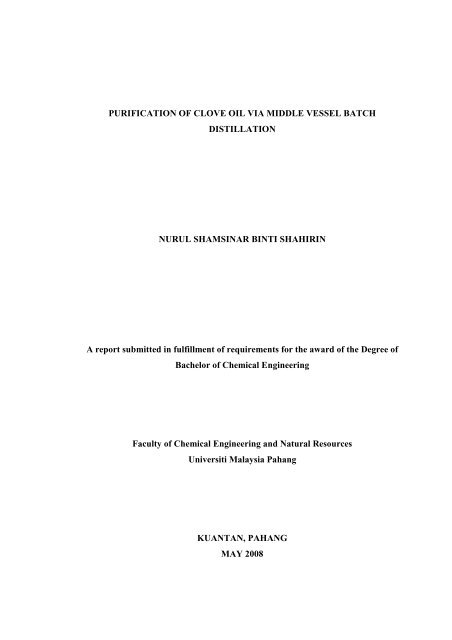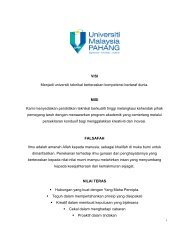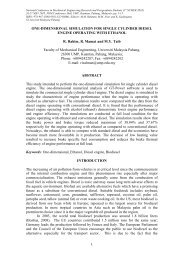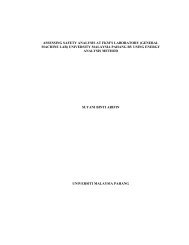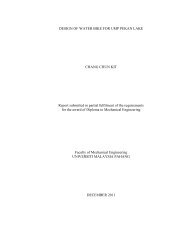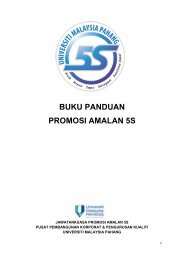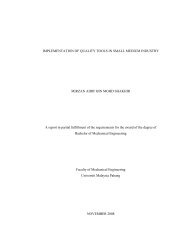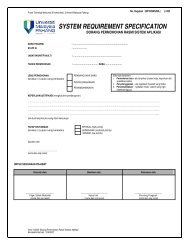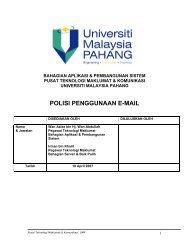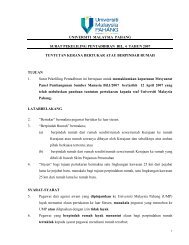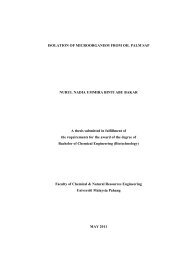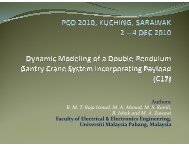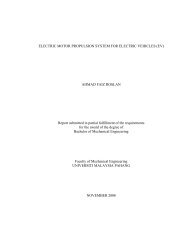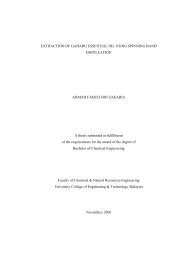purification of clove oil via middle vessel batch - Universiti Malaysia ...
purification of clove oil via middle vessel batch - Universiti Malaysia ...
purification of clove oil via middle vessel batch - Universiti Malaysia ...
You also want an ePaper? Increase the reach of your titles
YUMPU automatically turns print PDFs into web optimized ePapers that Google loves.
PURIFICATION OF CLOVE OIL VIA MIDDLE VESSEL BATCHDISTILLATIONNURUL SHAMSINAR BINTI SHAHIRINA report submitted in fulfillment <strong>of</strong> requirements for the award <strong>of</strong> the Degree <strong>of</strong>Bachelor <strong>of</strong> Chemical EngineeringFaculty <strong>of</strong> Chemical Engineering and Natural Resources<strong>Universiti</strong> <strong>Malaysia</strong> PahangKUANTAN, PAHANGMAY 2008
ii“I declare that this thesis is the result <strong>of</strong> my own research expect as cited references.The thesis has not been accepted for any degree is concurrently submitted incandidature <strong>of</strong> any degree.”SignatureName <strong>of</strong> Candidate:...……………………………………………: NURUL SHAMSINAR BINTI SHAHIRINDate : 16 MAY 2008
iiiIn the name <strong>of</strong> AllahTo my beloved parents and family
ivACKNOWLEDGEMENTIn the name <strong>of</strong> Allah, I am very thankful to Him because allowed and give mestrength to finish this thesis. In particular, I wish to express my sincere appreciationto my supervisor, Ms. Siti Zubaidah bt. Sulaiman for her encouragement, guidanceand advices in order to finish my project. A lots <strong>of</strong> thank also I regard to my cosupervisor,Mr. Anwaruddin Hisyam whose give efforts and guideline to me infinishing this project. They have contributed towards my understanding and thoughtsduring this project development. Without their continued support and interest, thisthesis would not be a success.I am also indebted to the staff <strong>of</strong> Faculty <strong>of</strong> Chemical and Natural ResourcesEngineering especially to Vocational Officer for their kindness and cheerfulness ingives their hand while conducting my project.Special thankful is also extends to all my colleagues and others who haveprovided assistance at various occasions. Their views and tips are useful indeed.Lastly, but not least I regard my special thank and love to my parents and otherfamily members for their continuous support while completing this project.
vABSTRACTBatch distillation process is becoming increasingly important because <strong>of</strong> itsflexibility. However, regular <strong>batch</strong> distillation required high energy consumption andhigh residence time in the column. Middle Vessel Batch Distillation is one <strong>of</strong> thealternative configurations to overcome these problems. In this study, Middle VesselBatch Distillation is used to purify crude <strong>clove</strong> <strong>oil</strong>. The scopes <strong>of</strong> this study are basedon the effects <strong>of</strong> <strong>vessel</strong> holdup and operating time <strong>of</strong> distillation process. Theobjectives are to obtain the separation performance <strong>of</strong> <strong>clove</strong> <strong>oil</strong> by using <strong>middle</strong><strong>vessel</strong> <strong>batch</strong> distillation column and to find out the effects <strong>of</strong> time and the <strong>middle</strong><strong>vessel</strong> holdups to the composition <strong>of</strong> Eugenol in <strong>clove</strong> <strong>oil</strong>. The samples <strong>of</strong> <strong>clove</strong> <strong>oil</strong>after the process are analyzed by Gas Chromatography. The performance separation<strong>of</strong> the Middle Vessel Batch Distillation column is fully understood. It is proven thatby varying <strong>vessel</strong> holdup and operating time, the separation performance areimproved.
viABSTRAKTurus penyulingan berkelompok merupakan satu peralatan untuk prosespenulenan bahan kimia yang amat efektif dan luas penggunaannya di dalam industrifarmasi. Penyulingan berkelompok menjadi proses penting di dalam industri keranasifat yang fleksibel. Dalam kajian ini, Penyulingan Berkelompok dengan TangkiTengah digunakan sebagai salah satu cara untuk menulenkan minyak cengkihmentah. Skop untuk kajian ini adalah berdasarkan kesan penghadang tangki danmasa operasi kepada proses penyulingan. Tujuan kajian ini adalah untukmengenalpasti prestasi pemisahan minyak cengkih menggunakan turus PenyulinganBerkelompok dengan Tangki Tengah. Selain itu, mengenalpasti kesan penghadangtangki dan masa operasi ke atas komposisi minyak cengkih. Sampel daripadaeksperimen akan dianalisis menggunakan Kromatografi Gas. Eksperimen ini dapatmengenalpasti penghadang tangki yang terbaik untuk mendapatkan komposisiEugenol yang tertinggi. Selain itu, ia juga dapat mengurangkan masa operasi prosesberbanding menggunakan penyulingan berkelompok biasa.
viiTABLE OF CONTENTSCHAPTER TITLE PAGETITLE PAGEDECLARATIONDEDICATIONACKNOWLEDGEMENTABSTRACTABSTRAKTABLE OF CONTENTLIST OF SYMBOLSLIST OF FIGURESLIST OF TABLESLIST OF APPENDICESiiiiiiivvviviiixxxiixiii1 INTRODUCTION 11.1 Background <strong>of</strong> Study 11.2 Problem Statement 41.3 Objective 51.4 Scope 52 LITERATURE REVIEW 72.1 Purification 72.2 Essential <strong>oil</strong> 82.2.1 Clove <strong>oil</strong> 9
ixLIST OF SYMBOLST - Temperaturet - TimeF in - Volumetric feed rate to the columnV’ - Molar vapor b<strong>oil</strong>up rateD - Molar distillate rateHVessel Holdup
xLIST OF FIGUREFIGURE TITLE PAGE2.1 Clove buds and leaves 92.2 Batch Rectifier 142.3 Batch Stripper 162.4 Principle structure <strong>of</strong> MiddleVessel Batch Distillation 182.5 A schematic diagram <strong>of</strong> basicGas Chromatography 223.1 Middle Vessel Batch Distillationat Lab FKKSA 243.2 Vessel holdup for <strong>middle</strong> andtop <strong>vessel</strong> 253.3 Flowchart <strong>of</strong> experimental proceduresMiddle Vessel Batch Distillation 263.4 Products after distillation <strong>via</strong> MiddleVessel Batch Distillation 273.5 Flow <strong>of</strong> sample preparation for GCanalysis 283.6 Sample for GC analysis 283.7 Gas Chromatography in FKKSAlaboratory 293.8 Process Flow Diagram 304.1(a) (b) (c) (d)(e) Graph Temperature vs time atAtmospheric pressure 32
ix4.2(a)(b)(c)(d)Graph Temperature vs time atVacuum pressure 354.3 Sample Analysis Result GC 38
ixLIST OF TABLETABLE TITLE PAGE1.1 Identified constituents in Clove <strong>oil</strong> 22.1 Properties <strong>of</strong> Eugenol 114.1 Data from Calculation <strong>of</strong> Composition 39
xLIST OF APPENDICESAPPENDIX TITLE PAGEA GC Analysis Result 47B GC Analysis Data Calculation 62
CHAPTER 1INTRODUCTION1.1 Background <strong>of</strong> StudyNowadays, fine chemicals have high value added in market. High demands fromthe industries give results to the increasing production <strong>of</strong> fine chemicals. Newdevelopment in industries especially in pharmaceutical, cosmetics, foods, and aromaticapplication, fine chemicals become the main ingredient to these productions. Essential<strong>oil</strong> is one <strong>of</strong> the valuable fine chemicals. Jasmine <strong>oil</strong>, Gaharu <strong>oil</strong>, Chamomile <strong>oil</strong>, Clove<strong>oil</strong>, Garlic <strong>oil</strong> and Ginger <strong>oil</strong> are some <strong>of</strong> the essential <strong>oil</strong> that widely used inaromatherapy, foods and pharmaceutical uses. In aromatherapy, essential <strong>oil</strong> can giverelaxation, release stress and powerful in healing body ability. Essential <strong>oil</strong> used as thebest flavor in foods industries. Pharmaceutical research gives results that some <strong>of</strong>
2essential <strong>oil</strong> is used as main ingredient in the medicine. In conclusion, benefits <strong>of</strong>essential <strong>oil</strong> are infinitive and nowadays essential <strong>oil</strong> has high value added in market.Clove <strong>oil</strong> is one <strong>of</strong> the essential <strong>oil</strong> that exists in the world. Clove <strong>oil</strong> wasextracted from the <strong>clove</strong> buds. Figure 1.1, shows the <strong>clove</strong> buds which <strong>clove</strong> <strong>oil</strong> isextracted from. It is used in pharmaceutical and aromatherapy. There aremulticomponent compositions in the <strong>clove</strong> <strong>oil</strong> such as esters, aldehydes, terpeneseugenol and others. However, Eugenol is an active ingredient in <strong>clove</strong> essential <strong>oil</strong>.Eugenol is important in the dental pain relief. It is also used in numbing the gums. Thereis about 80% <strong>of</strong> Eugenol in the <strong>clove</strong> <strong>oil</strong>. Figure 1.1 shows table <strong>of</strong> composition andolfactoric data <strong>of</strong> <strong>clove</strong> <strong>oil</strong> analyze by Gas Chromatography (Jirovetz et. al, 2006)Table 1.1: Identified constituents in <strong>clove</strong> <strong>oil</strong>Reff: Jirovetz et. al, 2006
3From the Table 1.1, there are 23 identified constituents in the <strong>clove</strong> <strong>oil</strong> and for Eugenol,76.8% were identified as a major compound in the composition <strong>of</strong> <strong>clove</strong> <strong>oil</strong>.The fine chemical industry works with high variety <strong>of</strong> chemical products with ahigh added value, which are changing continuously following market fluctuations andhave a small lifetime. This implies that <strong>batch</strong> distillation must be flexible unit operationand must be able to separate the changing mixtures efficiently (Bonsfills and Puigjaner,2004).In order to fulfill demand in production <strong>of</strong> essential <strong>oil</strong>; in chemical engineering,process to extract valuable component in essential <strong>oil</strong> was improved to maintain thepurity <strong>of</strong> essential <strong>oil</strong>. Crude essential <strong>oil</strong>s are purified in <strong>batch</strong> distillation columns inorder to enrich the product in some components while decreasing the amount <strong>of</strong> othercomponents. Batch distillation is very efficient which allows the fractionation <strong>of</strong>multicomponent mixture into pure constituents in a <strong>batch</strong> distillation column. It is alsoused when there are large variables in feed composition or when production rates arevarying. Batch distillation is also needed in production <strong>of</strong> small amounts <strong>of</strong> productswith high value added especially in <strong>purification</strong> <strong>of</strong> essential <strong>oil</strong>s. This has led toalternative configurations <strong>of</strong> <strong>batch</strong> distillation, including <strong>batch</strong> stripper, <strong>middle</strong> <strong>vessel</strong>column and multi<strong>vessel</strong> column.Middle Vessel Batch Distillation column was introduced to increase thecapabilities <strong>of</strong> <strong>batch</strong> distillation column in <strong>purification</strong> process. Hasebe et. al. (1992)comes with the new idea; with the facts <strong>middle</strong> <strong>vessel</strong> is to overcome high energydemands and high temperature in feed <strong>vessel</strong> <strong>of</strong> regular <strong>batch</strong> distillation column. Inregular <strong>batch</strong> distillation, the optimal operation <strong>of</strong> the process is strongly depends on thereflux policy and using <strong>of</strong> <strong>of</strong>f-cuts. Besides, by using Middle Vessel Batch Distillationcolumn, it is more efficient because the <strong>batch</strong> time for given heat input is shorter. So
4that, with this found, Middle Vessel Batch Distillation can lead to lower temperatures inthe feed <strong>vessel</strong>, energy and entrainer savings and easier handling <strong>of</strong> the liquid fractionsinvolved in the process.Middle Vessel Batch Distillation column operation is total reflux policy which isno reflux ratio used in the process. This column configuration has gained a lot <strong>of</strong>attention in the last few years. The presence <strong>of</strong> a <strong>middle</strong> <strong>vessel</strong> and <strong>of</strong> recycling streamsto and from the column provides an extra degree <strong>of</strong> freedom for column operation(Barolo et. al., 1996). In this column, the feed is charged to a <strong>vessel</strong> that is placed in the<strong>middle</strong> <strong>of</strong> the column. Products and impurities are taken <strong>of</strong>f from both column ends. Thetotal reflux operation is particularly advantageous because neither the yield nor thequality <strong>of</strong> the products is influenced by variations in the heating rate or interruption <strong>of</strong>the distillation; also, no product changeovers are required during the distillation, so thatcolumn operation is easier (Barolo et. al., 1996). There are several parameters need toconsider in control the optimum operation <strong>of</strong> <strong>batch</strong> distillation with <strong>middle</strong> <strong>vessel</strong> thatstill in research.1.2 Problem StatementIn regular <strong>batch</strong> distillation process, the feed <strong>vessel</strong> required high energy andhigh temperature <strong>of</strong> the column. In addition, high residence time <strong>of</strong> the column may leadto the decomposition <strong>of</strong> substances. Thus, <strong>middle</strong> <strong>vessel</strong> with total reflux policyoperation is come out to improve the process <strong>of</strong> <strong>batch</strong> distillation. In the operation,<strong>vessel</strong> holdups and operating time are some <strong>of</strong> parameters need to consider that canaffect the performance <strong>of</strong> column in separation process. Effects <strong>of</strong> <strong>vessel</strong> holdups and
5operating time to the separation performance are obtained by varying those parametersduring experiment.1.3 ObjectiveThe objectives <strong>of</strong> this research are:• To understand the separation performance <strong>of</strong> crude essential <strong>oil</strong> using <strong>middle</strong><strong>vessel</strong> <strong>batch</strong> distillation column.• To determine the <strong>vessel</strong>s hold-up to the <strong>purification</strong> process using <strong>middle</strong> <strong>vessel</strong><strong>batch</strong> distillation column.• To determine operating time using <strong>middle</strong> <strong>vessel</strong> <strong>batch</strong> distillation column.1.4 ScopeIn general, the scopes <strong>of</strong> the research include conducting various experiments tostudy the effects <strong>of</strong> <strong>vessel</strong> holdups and operating time to the Middle VesseI BatchDistillation.
6In the Middle Vessel Batch distillation column, several parameters need to beconsidered in giving higher separation performance <strong>of</strong> the column. Vessel holdups andoperating time are the parameters that will be studied in this research. Three <strong>vessel</strong>holdups will be varied to optimize the best performance <strong>of</strong> separation in the results <strong>of</strong>the experiments. Operating time for the process is determined by varying the time <strong>of</strong> theexperiments.
CHAPTER 2LITERATURE REVIEW2.1 PurificationPurification in terms <strong>of</strong> language is the process <strong>of</strong> rendering something pure orclean <strong>of</strong> foreign elements. In chemical context, <strong>purification</strong> is the physical separation <strong>of</strong>a chemical substance <strong>of</strong> interest from foreign or contaminating substances 1 . Methods inindustry that are relevant to purify the chemicals substance are filtration, centrifugation,evaporation, extraction, crystallization, distillation and adsorption. Each process haveown specifications to purify chemical substances. Performance <strong>of</strong> separation alsodepends on the process <strong>of</strong> <strong>purification</strong>. For example, distillation process is used to purifyEugenol in the Clove <strong>oil</strong>. Essential <strong>oil</strong> mixtures are <strong>of</strong>ten thermal sensitive materials, sothat to avoid decompositions <strong>of</strong> the materials, <strong>batch</strong> distillation process is known usedwidely in industry over the past decade.1http://www.wikipedia.com/<strong>purification</strong>
82.2 Essential OilEssential <strong>oil</strong> is an aromatic herbs or aromatic plants which are generallyextracted by distillation. Essential <strong>oil</strong> is concentrated, hydrophobic liquid containingaroma compounds from plants. Essential <strong>oil</strong> is also known as volatile or ethereal <strong>oil</strong>s,which is the <strong>oil</strong> <strong>of</strong> the plant materials from which essential <strong>oil</strong>s were extracted such as<strong>oil</strong> <strong>of</strong> <strong>clove</strong> 2 . Plant materials are consisting <strong>of</strong> flowers, leaves, woods, barks, roots, seedsor peels.Beside distillation as a process to extract essential <strong>oil</strong> from plant materials, thereare expression and solvent extraction that are known widely in industry. In distillationprocess, raw plant materials are put into a distillation apparatus over water. As the wateris heated, the steam passes through the plant materials and vaporizing the volatilecompounds. The vapor will condensed into liquid through a c<strong>oil</strong> <strong>of</strong> cooling water whichthen collected in receiving <strong>vessel</strong>. Other than that, expression process also used which isplant materials are expressed mechanically. However, this method is only suitable to thecertain types <strong>of</strong> plant materials. It is due to the large quantities <strong>of</strong> <strong>oil</strong> in the plantmaterials. Meanwhile, solvent extraction is known used to extract the <strong>oil</strong> from plantmaterials. A solvent such as hexane or supercritical carbon dioxide is used to extract the<strong>oil</strong>s. By lowering the extraction temperature, the solvent will separate the waxes fromthe essential <strong>oil</strong>s. This lower temperature process prevents the decomposition anddenaturing <strong>of</strong> compounds and provides superior products.In history, in the different periods, various essential <strong>oil</strong>s have been usedmedicinally. Essential <strong>oil</strong> is used in skin treatment to remedies for cancer. In recentdecades, essential <strong>oil</strong> come out with popularity <strong>of</strong> aromatherapy, a branch <strong>of</strong> alternative2http://en.wikipedia.org/wiki/Essential_<strong>oil</strong>
9medicine which claims that essential <strong>oil</strong>s have medical properties that have been appliedsince ancient times and widely used until today.2.2.1 Clove <strong>oil</strong>Syzygium aromaticum, Eugenia aromaticum or Eugenia caryophyllata aresynonyms to the <strong>clove</strong>s tree. In the family <strong>of</strong> Myrtaceae, the <strong>clove</strong> trees are grow inrange 10-20 m <strong>of</strong> height with having oval leaves and crimson flowers. Firstly, flowerbuds have a pale color and become green gradually. When in bright red color, flowerbuds are ready for harvesting.Figure 2.1: Clove buds and leavesAccording to Food and Agriculture Organization (FAO), Indonesia producedalmost 80% <strong>of</strong> the world’s <strong>clove</strong> output in 2005 followed at a distance by Madagascar
10and Tanzania 3 . In India, <strong>clove</strong>s called as Lavang that used in Ayurveda and mostly usedfor dental emergencies. The essential <strong>oil</strong> is used in aromatherapy when stimulation andwarming is needed, especially in digestive problems. Application over the stomach orabdomen will warm the digestive tract.Major component in the essential <strong>oil</strong> <strong>of</strong> <strong>clove</strong> is Eugenol. It is about 72% - 90%<strong>of</strong> Eugenol in the <strong>clove</strong> <strong>oil</strong>. Eugenol has well-defined antiseptic and anaestheticproperties 4 .2.2.2 Eugenol and the ImportanceEugenol (C 10 H 12 O 2 ) is an allyl chain-subtituted guaiacol. Eugenol also known as2-methoxy-4-allylphenol. In chemical compounds, Eugenol is a member <strong>of</strong> theallylbenzene class. The characteristics <strong>of</strong> Eugenol are clear to pale yellow <strong>oil</strong>y liquidextracted from certain essential <strong>oil</strong>s especially from <strong>clove</strong> <strong>oil</strong>. It is slightly soluble inwater and soluble in organics solvents and has a pleasant, spicy, <strong>clove</strong>-like aroma.Eugenol is widely used in application <strong>of</strong> dentistry. When Eugenol mixed with zincoxide, zinc oxide eugenol is formed which has restoration in dental medicinal. It is alsoused as a flavoring agent in food and cosmetic products and has pro-oxidant andantioxidant activities. The addition <strong>of</strong> antioxidants to food products earns increasingpopularityas a powerful means for extending the shelf-life <strong>of</strong> products and fordecreasing the nutritional losses by preventing or slowing the oxidation process (Jirovetzet. al, 2006). In Table 2.1 shows briefly the properties <strong>of</strong> Eugenol that exist in the plantmaterials and extracted by distillation or solvent extraction.34http://en.wikipedia.org/wiki/Clovehttp://en.wikipedia.org/wiki/Clove
11Table 2.1: Properties <strong>of</strong> Eugenol 52DMolecular structure3DIUPAC NameOther namesMolar massEugenol2-Methoxy-4-(2-propenyl)phenolAllylguaiacol4-Allyl-2-methoxyphenolEugenic acidCaryophyllic acid1-Allyl-3-methoxy-4-hydroxybenzene5-Allylguaiacol2-Methoxy-4-allylphenol164.20 g/molDensity 1.06 g/cm 3Melting point -9B<strong>oil</strong>ing point 2565http://en.wikipedia.org/wiki/Eugenol
122.2.3 Reaction <strong>of</strong> EugenolIn reaction, Eugenol is converted to the ester by acetylation reaction and furtherprocess into vanillin by oxidation reaction. Briefly, there is how to obtain Eugenol byesterification reaction and oxidation reaction. In esterification reaction, alcohol isreacted with carboxylic acid to produce carboxylic ester. Ester can be produced byreflux <strong>of</strong> alcohol and acid carboxylic. Alcohols also function as solvent in this reaction.The esterification reaction is stated below:Oxidation reaction in organic chemistry is reduction <strong>of</strong> H atom or new bond isformed between C and H. There are two types <strong>of</strong> oxidation. First, oxidation <strong>of</strong> bondwithout breaks the bond. Second is oxidation <strong>of</strong> bond with breaks the bond.Oxidation without breaks the bond will produced epoxide or diol, meanwhile oxidationwith break the bond will produced aldehyde and ketone <strong>of</strong> acid carboxylic. Commonly,reactants that used for alkene oxidation are KMnO 4 , OsO 4 , C 6 H 5 CO 3 H, CF 6 CO 3 H andO 3 . In conclusion, oxidation <strong>of</strong> methyl iso-eugenol with KMnO 4 is oxidation with breaksthe bonds and followed by bonds break that produced vanillin. Purity <strong>of</strong> Eugenol isanalyzed using Gas Chromatography.2.3 Batch Distillation in Theory
13Distillation is a method <strong>of</strong> separating chemical substances based on differencesin their volatilities in a mixture. Distillation usually forms part <strong>of</strong> a larger chemicalprocess, and is thus referred to as a unit operation. Commercially, distillation has anumber <strong>of</strong> uses. It is used to separate crude <strong>oil</strong> into more fractions for specific uses suchas transport, power generation and heating. Water is distilled to remove impurities, suchas salt from sea water. Air is distilled to separate its components such as oxygen formedical applications and helium for balloons. The use <strong>of</strong> distillation on fermentedsolutions to produce distilled beverages with higher alcohol content is perhaps the oldestform <strong>of</strong> distillation, known since ancient times. Distillations <strong>of</strong> essential <strong>oil</strong> usually use<strong>batch</strong> distillation method significantly <strong>batch</strong> distillation is a very efficient unit operationwhich allows the fractionation <strong>of</strong> multi-component mixture into its pure constituents in asingle column.In the last few years, <strong>batch</strong> distillation has received increasing attention because<strong>of</strong> its simplicity <strong>of</strong> operation, flexibility and lower capital cost rather than continuousdistillation. Batch distillation is a single column that can separate many differentcomponents from a multi-component feed <strong>of</strong> multiple cuts with different productspecification from binary feed. The use <strong>of</strong> <strong>batch</strong> distillation is becoming increasinglyimportant for the separation and <strong>purification</strong> <strong>of</strong> high-value chemicals in many chemicals,food and pharmaceutical processes (Barolo, et .al, 1996). In <strong>batch</strong> distillation, a mixtureis distilled repeatedly to separate it into its component fractions before the distillationstill is again charged with more mixture. Contrast with continuous distillation, thefeedstock is added and the distillate is drawn <strong>of</strong>f without interruption. Batch distillationhas always been an important part <strong>of</strong> the production <strong>of</strong> seasonal or low capacity andhigh-purity chemicals.According to Barolo et. al, 1996, traditionally, the most popular kind <strong>of</strong> <strong>batch</strong>column is the so-called ‘regular’ or rectifying column, which is made up <strong>of</strong> a largerb<strong>oil</strong>er, to which all the feed is charged and <strong>of</strong> a rectifying section from whose top cuts <strong>of</strong>
14different compositions are removed. The <strong>batch</strong> rectifier consists <strong>of</strong> a pot, rectifyingcolumn, a condenser, some means <strong>of</strong> splitting <strong>of</strong>f a portion <strong>of</strong> the condensed vapor ordistillate as reflux, and one or more receivers. The pot is filled with liquid mixture andheated. Vapor flows upwards in the rectifying column and condenses at the top. Usually,the entire condensate is initially returned to the column as reflux. This contacting <strong>of</strong>vapor and liquid considerably improves the separation. Generally, this step is namedstart-up. After some time, a part <strong>of</strong> the overhead condensate is withdrawn continuouslyas distillate and it is accumulated in the receivers, and the other part is recycled into thecolumn as reflux. Figure 2.2, shows the basic <strong>of</strong> <strong>batch</strong> rectifier exist in the <strong>batch</strong>distillation process.
15CondenserRoundbottomflaskHeaterManometerFigure 2.2: Batch rectifierLess frequently, an “inverted” or “stripping” <strong>batch</strong> column is preferred, forexample when the amount <strong>of</strong> the light component in the feed charge is small and theproducts are to be recovered at high purity (S rensen and Skogestad, 1995). In thiscolumn, the feed is charged to the top <strong>vessel</strong> and the products are withdrawn from thebottom, so that a smaller reb<strong>oil</strong>er can be used (Barolo, et. al, 1996). Stripper is invertedcolumn from the <strong>batch</strong> rectifier. During operation, after charging the pot and starting upthe system, the high b<strong>oil</strong>ing constituents are primarily separated from the chargemixture. The liquid in the pot is depleted in the high b<strong>oil</strong>ing constituents, and enriched inlow b<strong>oil</strong>ing ones. The high b<strong>oil</strong>ing product is routed into the bottom product receivers.
16The residual low b<strong>oil</strong>ing product is withdrawn from the charge pot. This mode <strong>of</strong> <strong>batch</strong>distillation is very seldom applied in industrial processes. Figure 2.3 shows the model <strong>of</strong><strong>batch</strong> stripper that exists.Recently several alternative column configurations have been developed, whichprimarily differ in the position <strong>of</strong> the major liquid holdup in the column leading to, the<strong>middle</strong> <strong>vessel</strong> and multi-<strong>vessel</strong> column configurations. All <strong>of</strong> alternatives makeimprovements on the basis <strong>of</strong> conventional <strong>batch</strong> distillation column. Although goodseparation results can be gained, capital cost is increased to retr<strong>of</strong>it the conventionalcolumn.
17CondenserFeed initialchargeReb<strong>oil</strong>erProductsFigure 2.3: Batch stripper2.4 Middle Vessel Batch DistllationFrom the study <strong>of</strong> Middle Vessel Batch Distillation previously, it shows theadvantages with this type <strong>of</strong> distillation. It can lead to lower temperature in the feed<strong>vessel</strong>, to energy and entrainer savings and to an easier handling <strong>of</strong> the liquid fractions
18involved in the process (M. Warter, 2001). Middle Vessel Batch Distillation column is acombination <strong>of</strong> a regular and an inverted <strong>batch</strong> distillation and was originally proposedby Robinson and Gilliland (1950). The column is divided into a rectifying and astripping section by the feed <strong>vessel</strong> which is connected to the <strong>middle</strong> <strong>of</strong> the column.With this type <strong>of</strong> process it is possible to obtain simultaneously light and heavy b<strong>oil</strong>ingfraction accumulates in the <strong>middle</strong> <strong>vessel</strong>. In addition, <strong>middle</strong> <strong>vessel</strong> column can beequipped with a smaller reb<strong>oil</strong>er compared to that <strong>of</strong> a regular <strong>batch</strong> column (Barolo, et.al, 1996). With the total reflux operation, there are two degrees <strong>of</strong> freedom which areholdups and product flows as degree <strong>of</strong> freedom. There are no influenced by heating rateand also there are no product changeovers are required during the distillation, so that thecolumn operation is easier. In Figure 2.4, it shows the principle structure <strong>of</strong> a <strong>middle</strong><strong>vessel</strong> <strong>batch</strong> distillation.In the Middle Vessel Batch Distillation column, several components areimportant in the column to function efficiently. Stages in <strong>middle</strong> <strong>vessel</strong> <strong>batch</strong> distillationcolumn have function in varying feed systems and different separation tasks. Thenumber <strong>of</strong> the stages gives same influence on the energy demand <strong>of</strong> a separation as inany other distillation process i.e. with increasing number <strong>of</strong> stages the energy demanddecreases (M. Warter et. al, 2002).The location <strong>of</strong> the withdrawal and reflux to and from the <strong>middle</strong> <strong>vessel</strong> has a biginfluence on the energy demand (M. Warter et. al, 2002). The separation that carried outin the upper column section is consuming and determines the energy demand
19Vessel 3Vessel 2Vessel 1(Reb<strong>oil</strong>er)Figure 2.4: Principle structure <strong>of</strong> a <strong>middle</strong> <strong>vessel</strong> <strong>batch</strong> distillation(M. Warter et. al, 2002). The separation that carried out in the upper column section isconsuming and determines the energy demand <strong>of</strong> the whole process. Vice versa, for avery low location <strong>of</strong> the withdrawal the separation carried out in the lower columnsections determines the total energy demand.
20Heat exchanger in withdrawal and reflux line <strong>of</strong> the <strong>middle</strong> <strong>vessel</strong> gives the roleto the column to keep the temperature <strong>of</strong> the charge in the <strong>middle</strong> <strong>vessel</strong> as low aspossible. Hence, it will avoid the decomposition <strong>of</strong> critical substances. In the heatexchanger, the heat will exchange between the hot stream leaving the column and thecold reflux line from the <strong>middle</strong> <strong>vessel</strong>. In this way, the stream leaving the column iscooled down before entering the <strong>middle</strong> <strong>vessel</strong> keep at low temperature in the <strong>vessel</strong>.Reb<strong>oil</strong>er in the <strong>middle</strong> <strong>vessel</strong> <strong>batch</strong> distillation column generates a vapour streamentering the upper column section. The flow rate <strong>of</strong> this stream can be manipulated to‘steer’ the concentration in the <strong>middle</strong> <strong>vessel</strong> (M. Warter et. al, 2002). There existdifferent modifications <strong>of</strong> the column section connected to the withdrawal and refluxline <strong>of</strong> the <strong>middle</strong> <strong>vessel</strong>. This modification <strong>of</strong> the column can lead from athermodynamic point <strong>of</strong> view, to energy savings in a <strong>batch</strong>wise extractive distillation(M. Warter et. al, 1999).2.4.1 Advantages <strong>of</strong> Middle Vessel Batch Distillation OperationIn the <strong>batch</strong> distillation process, the feed is exposed from the beginning to hightemperatures. This situation can be harmful for substances which tend to decompose. In<strong>middle</strong> <strong>vessel</strong> <strong>batch</strong> distillation, only the fraction <strong>of</strong> feed charged to the sump is heatedup to the bubble point temperature at the beginning, while normally big part in the<strong>middle</strong> <strong>vessel</strong> is just exposed to ambient temperature. Rather to regular <strong>batch</strong> distillation,temperature is increasing lower and the temperature never reaches the b<strong>oil</strong>ing pointtemperature <strong>of</strong> the high b<strong>oil</strong>er.
21In the regular <strong>batch</strong> process the product is kept in the reb<strong>oil</strong>er as long as the lowb<strong>oil</strong>ing impurities are removed from top <strong>of</strong> the column. In the <strong>middle</strong> <strong>vessel</strong> <strong>batch</strong>distillation process, only the amount <strong>of</strong> product which is in the sump gets in contact withthe reb<strong>oil</strong>er surface.The smaller amounts <strong>of</strong> liquid in the reb<strong>oil</strong>er <strong>of</strong> a <strong>middle</strong> <strong>vessel</strong> column lead toadvantages in the start-up <strong>of</strong> the column. While in a regular <strong>batch</strong> distillation process thetotal amount <strong>of</strong> feed is heated up to the b<strong>oil</strong>ing point at the start-up <strong>of</strong> the process, it isjust small amount when using a <strong>batch</strong> distillation with a <strong>middle</strong> <strong>vessel</strong>. In addition, theprocess <strong>of</strong> <strong>middle</strong> <strong>vessel</strong> proved to save time because there is separation stagesperformed simultaneously.2.4.2 Total Reflux Policy OperationBortolini and Guarise (1971) was suggested total reflux operation for aconventional <strong>batch</strong> distillation column. (Wittgens, B.et al, 1996). The simplest operationstrategy is with only one cycle, that is, the column is operated under total reflux and thefinal products are collected in the condenser drum and in the reb<strong>oil</strong>er. They alsosuggested using a <strong>middle</strong> <strong>vessel</strong> where the feed is charged to the <strong>middle</strong> <strong>of</strong> the column.In 1995, Hasebe comes with a multi<strong>vessel</strong> column with total reflux that can separatemore than two components. The policies can be implemented in the multi<strong>vessel</strong> <strong>batch</strong>distillation column with both holdups and product flows as degrees <strong>of</strong> freedom. Thesimplest operation form <strong>of</strong> total reflux operation is that suggested by Hasebe (1995)where the product rates are set to zero (D i = 0). In this operation, it is simpler since noproduct changeovers are required during operation. In addition, the energy requirementis less where the heat is required for the separation is supplied to the reb<strong>oil</strong>er and cooling
22is done only at the top. The advantage <strong>of</strong> cyclic operation to the <strong>middle</strong> <strong>vessel</strong> comparedto regular <strong>batch</strong> column, the process gives rise to no <strong>of</strong>f-cuts if separation efficiency ishigh enough. In total reflux operation, theoretically, the bottom <strong>vessel</strong> <strong>of</strong> every columnand reflux drum is filled with the raw material and the heat supplied to the bottom <strong>vessel</strong>(reb<strong>oil</strong>er) <strong>of</strong> the first column. The vapor from the top <strong>of</strong> a column is supplied to thebottom <strong>of</strong> the next column, and the liquid in the bottom <strong>vessel</strong> is returned to the top <strong>of</strong>the previous column. By continuing total reflux operation, the ith heaviest component isaccumulated in the <strong>vessel</strong> <strong>of</strong> the column i. The operation is terminated when thecompositions <strong>of</strong> all <strong>vessel</strong>s satisfy the product specification (Hasebe, et. al, 1999).Operation at total reflux can be pr<strong>of</strong>itable when it is required to recover the mixturecomponents at very high degree <strong>of</strong> purity. In addition, the operation is simple becausethere is no product changeovers are necessary (Barolo, et. al, 1996).2.5 Vessel holdup and Operating timeVessel holdup and operating time are two <strong>of</strong> the parameters that considered inthis study. There are three <strong>vessel</strong> holdups at <strong>middle</strong> <strong>vessel</strong> and top <strong>vessel</strong>. In adjustingthe desired qualities, Hasebe et. al, (1997) suggested controlling the mass holdup in theproduct <strong>vessel</strong> directly. It is advantageous to vary the holdups, instead <strong>of</strong> keepingconstant by calculating the steady state value in advance. According to Barolo, et.al,(1998), the optimal or minimum <strong>batch</strong> distillation time is strongly dependent on the ratio<strong>of</strong> F in / V’ for F in V’ but it is weakly dependent on such a ratio for F in V’. Bysimulation and experimentally, the increasing <strong>of</strong> feed or withdrawal rates indeeddecreases the <strong>batch</strong> distillation time.
232.6 Gas ChromatographyGas chromatography is a chromatographic technique that can be used to separatevolatile organic compounds. The separations <strong>of</strong> organic compounds are due to thedifferences in partitioning behavior between the mobile gas phase and the stationaryphase in the column. Normally, a gas chromatography consists <strong>of</strong> a flowing mobilephase, an injection port, a separation column containing stationary phase, a detector anda data recording system. The schematic diagram <strong>of</strong> the basic gas chromatography isshown in Figure 2.5.Figure 2.5: A schematic diagram <strong>of</strong> basic gas chromatography
24Generally, mobile phases that used in gas chromatography are inert gases forinstance helium, argon or nitrogen. The injection port consists <strong>of</strong> a rubber septumthrough which a syringe needle is inserted to inject the sample. The injection port ismaintained at higher temperature than the b<strong>oil</strong>ing point <strong>of</strong> the least volatile componentin the sample mixture. The separation column is usually contained in thermostatcontrolledoven because <strong>of</strong> the partitioning behavior is dependent on temperature.Separating components with a wide range <strong>of</strong> b<strong>oil</strong>ing points is accomplished by startingat low oven temperature and increasing the temperature over time to elute the highb<strong>oil</strong>ingpoint components. Most columns contain a liquid stationary gas phase on asolids support. Separation <strong>of</strong> low-molecular weight gases is accomplished with solidadsorbents.
CHAPTER 3METHODOLOGY3.1 MaterialIn order to understand the behavior <strong>of</strong> separation performance for the operationprocess Middle Vessel Batch Distillation, experiments will be conducted during period<strong>of</strong> this research. Raw materials for the experiments are crude <strong>clove</strong> <strong>oil</strong>. From the crude,it is purified by using <strong>batch</strong> distillation with <strong>middle</strong> <strong>vessel</strong> column. Crude <strong>clove</strong> <strong>oil</strong> is inthe liquid phase and black in colour. It is obtained from extraction process. Extractionprocess is not conducted due to beyond the scope <strong>of</strong> this research. Therefore, it waspurchased from Indonesia. Before starting the experiment, crude <strong>clove</strong> is filtered toavoid muck at the <strong>vessel</strong> after heating.


